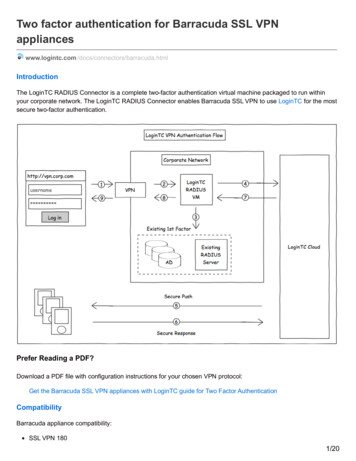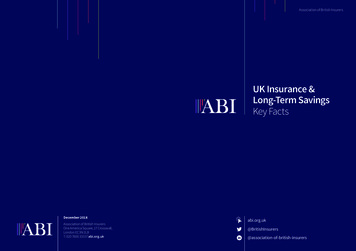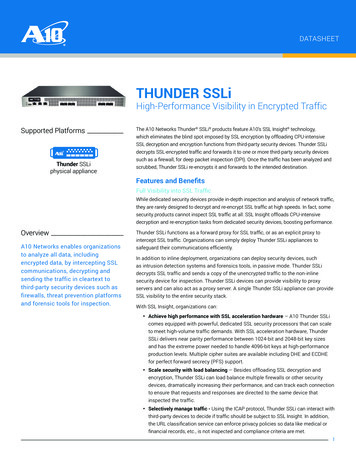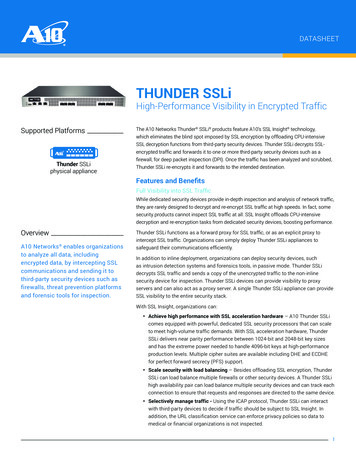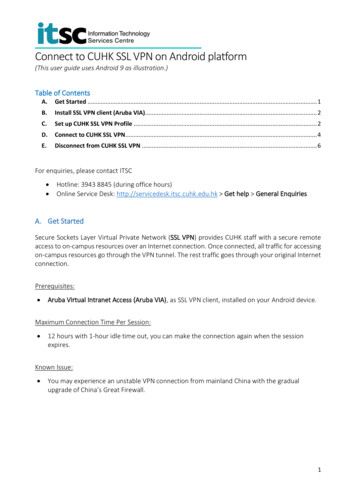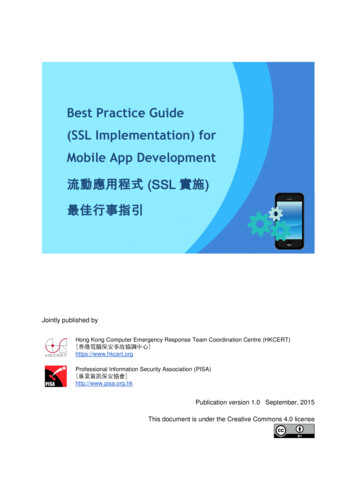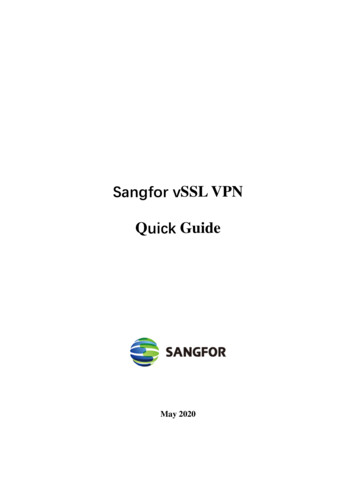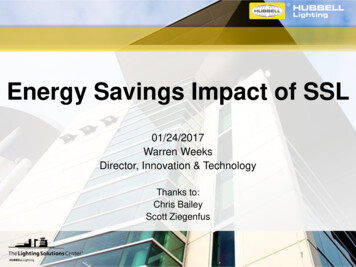
Transcription
Energy Savings Impact of SSL01/24/2017Warren WeeksDirector, Innovation & TechnologyThanks to:Chris BaileyScott Ziegenfus1
The Evolution of Artificial LightThe LED is the first commercially viable light source not based ona vacuum tube since the invention of the electric light in 1879.The solid-state lighting revolution began in 2006.2
Evolution of the LED55 Year History 012004200520062016First practical red LED invented on October 9 by Nick Holonyak (GE)“Blue” GaN MIS-LED demonstrated (Pankove)Yellow, red, and red-orange improved 10X by George Craford (HP)P-type GaN created by LEEBI (Nagoya University) – Akasaki, Amano, HiramatsuHigh quality p-type GaN grown; first pn-junction GaN LED (Nichia)Short-lived ZnSe-CdZnSe blue laser developed (3M)Commercial “candela-class” blue GaN LEDs introduced by Shuji Nakamura (Nichia)Bright quantum-well blue and green LEDs introduced (Nichia)Room temperature nitride “blue” laser diode demonstrated (Nichia)US demonstrates room temperature “blue” laser diode (Cree)First large area LED chips (Lumileds)Surface roughening for improved light extraction (Taiwan)Patterned substrate technology for improved light extraction (Japan)SONY markets Blu-Ray (HD-DVD) players (23 GB/layer)Large area LED chips with roughened surfacedSolid-state lighting revolution beginsGlobal SSL market nears 70B2014 Nobel Prize3
Hubbell LightingOne Company, Distinct Brands
Lighting Brand AlignmentRESIDENTIALRESIDENTIALCOMMERCIAL & RARCHITECTURALCOMPONENTSOUTDOORCOMMERCIALCONTROLS /COMPONENTS5
Operational ExcellenceOPERATIONS FOOTPRINTMANAGEMENT3,900 Employees10 StatesUnited States, Canada,Mexico, Puerto RicoMANUFACTURING10 Plants2.1 Million SFDISTRIBUTION8 Facilities1.1 Million SFCorporate HeadquartersDesign & Service CenterRegional Distribution CenterLighting ShowroomManufacturing6
From Electrical to ElectronicsLEGACY TECHNOLOGIESSOLID STATE SOLUTIONSInnovationApplied ResearchManufacturing Optical Design Reliability Electronic Assembly Electrical Design Efficiency Prototyping Thermal Design Durability Quality Control Source Technology Sustainability7
LED Sales AdoptionLED Sales 122013201420152016 YTD2017 EST8
Market MomentumHubbell Adoption by ht9
Conversion vs. OpportunityConversion of existing units10
US LED Forecast Stock Results for SSLSource: US DOE EERE September 201611
US DOE Energy Savings ForecastSource: US DOE EERE September 201612
Installed Projects for LightingSource: US DOE EERE September 201613
Current Energy SavingsSource: US DOE EERE July 201514
Why have energy codes? Reduce dependency on energyNational SecurityDecrease pollution from energy productionIncrease wealth of the nationOvercome “split incentives” Builder does not pay energy bills Landlord does not pay energy billsIncrease technological innovation Fuel injection, regenerative braking, CV transmission High frequency ballasts, tri-phosphors, LEDs, controls
The Stakeholder OrganizationsEPAct1992 / 2005ASHRAE 90.1EISAEnergy StarDesignLightsCEC Title 2416
Emergency of a National Energy Policy All 50 U.S. States received funding throughthe American Recovery and Reinvestment Actof 2009. The terms for acceptance of these fundsincluded agreement to put in place acommercial building energy code at least asstringent as ASHRAE 90.1-2010 States are required to achieve at least 90percent compliance with these codes by 2017.Source: American Society of Heating, Refrigerating and Air-Conditioning Engineers17
LegislationThe United States Lighting Energy Policy is moving towards increased efficiency inorder to lower green house gas emissions and energy use. Lighting efficiency improvements in the United States can be seen through different standards and acts2005 Energy Policy Act (EPAct) Tax incentive for energy efficient lighting (up to 0.60/ft²)For reductions 40% below ASHRAE/IESNA 90.1-2001 standardsExpired on December 31st, 20132007 Energy Independence & Security Act (EISA) Phase out of incandescent lamps and standard MH lamps ( 150W, 500W)2009 DOE Regulations Phase out of 4-foot T12 lamps, some 4-foot T8 lamps and nearly all standard PAR38, PAR30 and PAR20 lamps18
LegislationCA Title 24 2013 (Effective 2014) Outdoor lighting controls (clock & motion), glare & uplight, interior commercial dimming & controls, retrofit compliancetriggers (50% down to 10%) and 40% lamp/ballast replacementIn the 2008 standard, the word “control” occurs 594 times between the indoor and outdoor lighting manuals (200pages)Energy Star Minimum luminaire performance (electrical & photometric) and light quality (CRI, etc.). Varies by luminaire categoryPrimarily residential consumer focusDesign Lights Consortium (DLC) Lighting Facts Minimum luminaire performance (electrical & photometric) and light quality (CRI, etc.). Varies by luminaire categoryPrimarily commercial consumer (building owner & operator) focusIn most cases, a requirement for utility incentives19
DLC Technical Requirements Table V4.1 (11/01/2016)20
Rising Cost of Energy21
Population GrowthSource: World BankSince 1950
Electrical Energy Production by Source7% 5%Fossil Fuel19%Nuclear68%HydroSource: U.S. Energy Information Administration23
Building Energy Consumptionof primary energy24
Building Energy Consumptionof electrical energy25
Lighting Energy UsageOffice BuildingsRetail Buildings37%30%30%25%17%16%9%6%9% atingSpaceCoolingLighting uses more energy in commercialbuildings than any other appliance (U.S. DOE)Other
ASHRAE/IES 90.1-2010 Impactsite energy savings27
ASHRAE/IES 90.1-2010 Impactenergy cost savings28
ASHRAE/IES 90.1-1989 through ASHRAE 90.1-2013Lumen Power Density Requirements WarehouseParking GarageHealthcare .40.660.250.872013 2007 7.5%-16%-25%-30%-10%Lighting Power DensitiesUsing the Building Area Method29
ASHRAE/IES 90.1-2016Lumen Power Density Requirements WarehouseParking GarageHealthcare Clinic1999/2001Standard2013Standard 2001 90.811.060.480.150.82Lighting Power DensitiesUsing the Building Area Method30
Current State Adoption
Complying with ASHRAE/IES 90.1-2013Receptacle (wall plug) ControlRequires that 50% of receptacles (in a space have automatic shutoff control) Applies to 125 volt 15 and 20 Amp receptacles in private offices,open offices, computer classroomsRequires automatic control using: Time of day schedule Occupancy Sensor Other auto control based on occupancyExceptions: Spaces where automatic shutoff would be a safety/security issue Spaces where all loads require 24 hour operationASHRAE requirements for projects designed after December 20,201332
Complying with ASHRAE/IES 90.1-2013“Bi-level” Space Lighting ControlRequires that manually controlled lighting have at least one control step between30% and 70% of full lighting power, in addition to off (0%) Exceptions: Lights in corridors, Electrical/mechanical rooms Public Lobbies, Restrooms, Stairways, Storage Rooms Spaces with only one luminaire with rated input power less than 100W Space types with a lighting power allowance of less than 0.6W/ft² Could include Bi-level switching or dimmingASHRAE requirements for projects designed after December 20,201333
Complying with ASHRAE/IES 90.1-2013Automatic Lighting ShutoffAutomatic shutoff of all building lighting when not needed Intended to mean EVERYTHNIG including “night lights”considered part of egress lighting Compliance by on of three methods: Time of day schedule Occupancy Sensor “a signal from another control or alarm system ”ASHRAE requirements for projects designed after December 20, 201334
Complying with ASHRAE/IES 90.1-2013Manual-on RequirementAutomatic control devices shall not be set to Automatically turn the lighting on Manual “ON” or auto-ON-to-50%Exemptions: Public Corridors Stairwells Restrooms Others Automatic exemption removed for buildings less than 5,000ft²ASHRAE requirements for projects designed after December 20, 201335
Complying with ASHRAE/IES 90.1-2013Vacancy Sensor ControlSensor control in specific spaces Conference/meeting rooms and training roomsClassrooms and lecture hallsEmployee and lecture hallsStorage/supply rooms between 50ft² and 1000ft²Rooms used for document copying and printingDressing/locker rooms and Fitting roomOffice spaces up to 250ft²RestroomsASHRAE requirements for projects designed after December 20, 201336
Mandatory Lighting Control RequirementsAutomatic Bi-level Switching or Dimming RequiredStairwellOutdoor AreaParking GarageSource: Lighting Controls Association37
Complying with ASHRAE/IES 90.1-2013Stairwell 50% ReductionStairwell lighting must have automatic shutoff control Applies to lighting enclosed stairwells Must have control to automatically reduce lighting power inany control zone by at least 50% within 30min of alloccupants leaving zoneASHRAE requirements for projects designed after December 20, 201338
Complying with ASHRAE/IES 90.1-2013Parking Garage ControlParking garage lighting must be automatically controlled including daylighting Reduce lighting power by 30% or more when nooccupancy is detected in lighting zone Lighting zone must be 3,600ft² Daylight transition zone lighting (66ft wide by 50ft) mustbe separately controlled for eye adaption Daylight control required for lights within 30ft ofperimeter wall with net opening to wall ratio of 40% There are some exemptionsASHRAE requirements for projects designed after December 20, 201339
Complying with ASHRAE/IES 90.1-2013Advanced Exterior Lighting ControlRequires specific daylight and building operation lighting controls for exterior Lighting must be off during daylight conditions Building façade/landscape lighting must be off fromclosing or midnight (whichever comes first) Remain off until 6am or openingOther lighting including advertising signage, shall beautomatically reduced by at least 30% eitherafterhours or when area is unoccupiedASHRAE requirements for projects designed after December 20, 201340
Complying with CA Title 24 2013 Efficiency StandardsPHOTOCELLHBA WASP2AAL PCA-CCROSS SECTION VIEW41
Complying with CA Title 24 2013 Efficiency Standards42
The Emergence of Daylighting43
Complying with ASHRAE/IES 90.1-2013Daylighting Control – SidelightingSeveral addenda that: Require the automatic control of electric lighting when sidelighting is available Applied based on “primary sidelighted area” exceeding 250ft² Control is required for the general lighting over these areas Control must be multi-level photocontrol with two output levels 0-35%50-70%Continuous Dimming44
Comparing Lighting UpgradesThe scope can vary:Installing lightingcontrols &replacing lampsSystem-wideconversion toLED
Retrofit CostPer ft² of floor spaceHVACWindow Film 8.49 0.70 5.00HVAC retrofit cost is 69% greater than lightingAccording to UCLA’s survey of 129 commercial buildings ranging in size.Lighting
First-year Average SavingsHVAC 300,000?Window Film 200,000LightingYear-1 HVAC savings is 50% greater than lightingAccording to UCLA’s survey of 129 commercial buildings ranging in size.
Simple PaybackHVAC5yrs.Window Film 3yrs.2-3 yrs.LightingHVAC payback is 66-250% longer than lightingAccording to UCLA’s survey of 129 commercial buildings ranging in size.
Return on Investment (ROI)HVAC20%Window Film 33%33-50%Lighting provides a 50-250% greater return oninvestment compared to HVACAccording to UCLA’s survey of 129 commercial buildings ranging in size.Lighting
Types of Lighting Solutions (New & Retrofit)1. Lowest Initial Cost (cheap, cheap, cheap) Typically shortest payback Typically not the lowest wattage or most efficient May suffer from near-sightedness Short-term play You get what you pay for 2. Greatest potential initial savings/earnings Could possibly be the lowest initial cost (energy &maintenance) May not be optimized for lifetime expectations3. Best technical fit Probably not the least expensive May be the specified product May include “off balance sheet” benefit
SSL Lighting Revolution Continues Energy supply vs. demandWidespread expansion of energy policyGreen Building and shift to Retrofit & RelightRationalization of artificial lightingAdvancement of daylightingIntegration of high-level controls, automation and DREmergence of new light sourcesUnlimited flexibilityNew questions posed regarding light and human health51
Thank you! – Questions?Warren WeeksDirector, Innovation & Technologywweeks@hubbell.com 1 (864) 678-105052
1993 Commercial “candela-class” blue GaN LEDs introduced by Shuji Nakamura (Nichia) 1995 Bright quantum-well blue and green LEDs introduced (Nichia) 1996 Room temperature nitride “blue” laser diode
